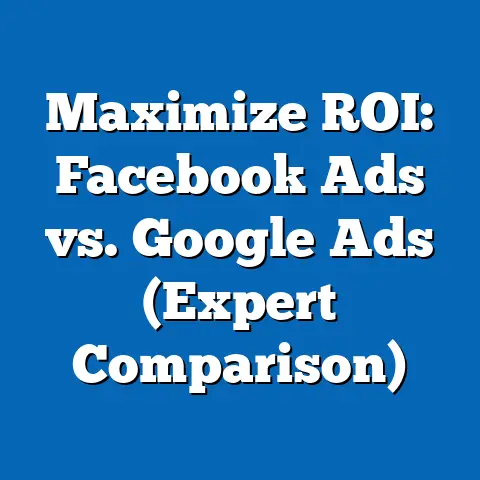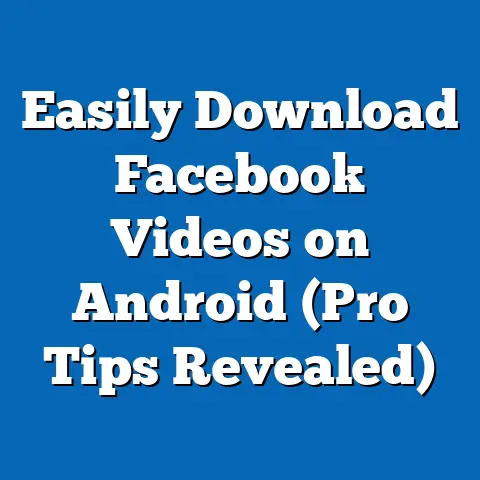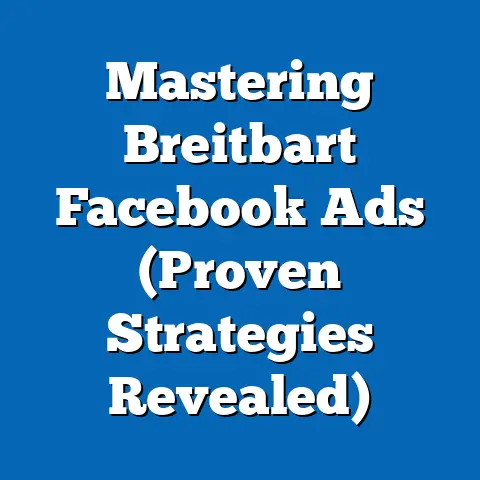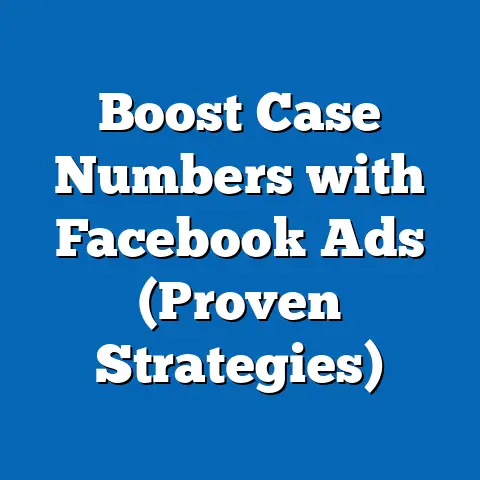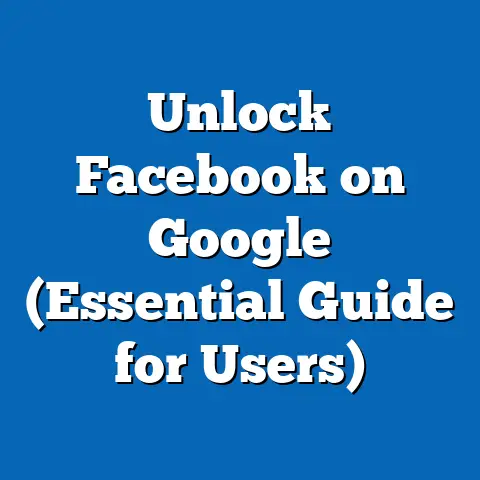Effortlessly Shift Facebook Ad Sets (Pro Tips Inside)
Picture this: It’s a Tuesday morning at a bustling digital marketing agency. The air is thick with the aroma of freshly brewed coffee and the low hum of keyboards. Around a large conference table, a team of dedicated marketers huddles, their faces illuminated by the glow of laptop screens. They’re deep in discussion, dissecting Facebook ad campaigns, meticulously analyzing metrics, and brainstorming strategies to squeeze every last drop of ROI from their ad spend. The pressure is on. The digital landscape is ever-changing, and the Facebook algorithm seems to have a mind of its own. Shifting ad sets effectively is the key to staying ahead, but it’s a delicate dance.
I’ve been in that room countless times. I know the feeling of urgency, the desire to unlock the secret sauce that will make campaigns sing. And believe me, mastering the art of shifting Facebook ad sets is a game-changer. It’s not just about tweaking a few settings; it’s about understanding the rhythm of your audience, the pulse of the platform, and the power of data-driven decisions.
This guide is designed to be your roadmap to effortless ad set shifting. Forget the guesswork and the frustration. Let’s dive into the pro tips that will transform your Facebook advertising strategy.
Understanding Facebook Ad Sets
Before we get into the nitty-gritty of shifting ad sets, let’s make sure we’re all on the same page about what they actually are. Think of your Facebook advertising campaign as a symphony. The overall campaign is the grand composition, the ad sets are the individual instruments sections (strings, woodwinds, brass), and the ads themselves are the notes that each instrument plays.
Facebook ad sets are essentially containers within your campaign where you define:
- Target Audience: Who are you trying to reach?
- Budget: How much are you willing to spend?
- Schedule: When will your ads run?
- Placements: Where on Facebook and Instagram will your ads appear?
- Optimization & Delivery: How will Facebook optimize your ads for the best results?
In essence, ad sets are the engine that drives your Facebook advertising. They allow you to tailor your message and budget to specific groups of people, increasing the chances of reaching the right audience with the right message at the right time.
The beauty of ad sets lies in their flexibility. You can create multiple ad sets within a single campaign, each targeting a different audience segment with a unique message and budget. This allows for granular control over your advertising spend and a much higher degree of personalization.
However, this power comes with responsibility. To truly harness the potential of ad sets, you need to continuously monitor their performance and make adjustments as needed. This is where the art of “shifting” ad sets comes into play.
Key Takeaway: Facebook ad sets are the foundation of your campaign, allowing you to target specific audiences, control budgets, and schedule ads. Continuous monitoring and adjustment are crucial for optimal performance.
The Importance of Shifting Ad Sets
Why is shifting ad sets so important? Imagine driving a car on a long road trip. You wouldn’t just set the cruise control and ignore the road conditions, right? You’d constantly adjust your speed, change lanes, and adapt to the changing environment.
Similarly, in the world of Facebook advertising, you can’t just create an ad set and expect it to perform optimally forever. Audiences evolve, trends shift, and the Facebook algorithm is constantly learning and adapting.
Here are some key reasons why you need to shift your ad sets:
- Audience Behavior Changes: People’s interests, demographics, and online habits are constantly evolving. What resonated with your audience last month might not resonate today.
- Seasonal Trends: Certain products or services are more popular during specific times of the year. Your advertising strategy needs to adapt to these seasonal fluctuations.
- Campaign Goals Evolve: As your business grows, your advertising goals might change. You might shift from brand awareness to lead generation, or from lead generation to sales.
- Ad Fatigue: This is a critical reason. Your audience gets tired of seeing the same ads over and over again. This leads to decreased engagement, lower click-through rates, and ultimately, a waste of your ad spend.
Statistics and Case Studies:
- According to a study by Nielsen, ad recall decreases by 15% after just one week of exposure to the same ad.
- A case study by HubSpot showed that refreshing ad creatives every 2-3 weeks resulted in a 30% increase in click-through rates.
- My own experience has shown that consistently shifting ad sets based on performance data can lead to a 20-40% improvement in overall ROI.
Ad Fatigue: The Silent Killer
I want to emphasize the importance of combating ad fatigue. It’s like a silent killer that slowly drains your campaign’s performance. Your audience starts to tune out your ads, even if they were initially interested. This leads to lower engagement, higher costs, and ultimately, a waste of your ad spend.
Shifting ad sets is one of the most effective ways to combat ad fatigue. By refreshing your creatives, targeting different audiences, or adjusting your bidding strategy, you can keep your ads fresh and engaging.
Key Takeaway: Shifting ad sets is crucial for adapting to changing audience behavior, seasonal trends, campaign goals, and combating ad fatigue. Consistent adjustments based on data can lead to significant improvements in ROI.
Pro Tips for Effortlessly Shifting Facebook Ad Sets
Now, let’s get to the meat of the matter: the pro tips that will help you effortlessly shift your Facebook ad sets for optimal performance.
Tip 1: Data-Driven Decision Making
This is the foundation of any successful Facebook advertising strategy. Don’t rely on gut feelings or intuition. Make your decisions based on data.
Before you even think about shifting an ad set, take a deep dive into its performance data. Here are some key metrics to monitor:
- Click-Through Rate (CTR): This measures the percentage of people who see your ad and click on it. A low CTR indicates that your ad isn’t resonating with your audience.
- Cost Per Click (CPC): This measures how much you’re paying for each click. A high CPC indicates that your ad is either not relevant to your audience or that you’re targeting a highly competitive audience.
- Conversion Rate: This measures the percentage of people who click on your ad and then take a desired action, such as making a purchase or filling out a form. A low conversion rate indicates that your landing page or offer isn’t compelling.
- Cost Per Acquisition (CPA): This measures how much you’re paying for each desired action. A high CPA indicates that your overall advertising strategy is inefficient.
- Return on Ad Spend (ROAS): This measures how much revenue you’re generating for every dollar you spend on advertising. This is the ultimate metric for measuring the success of your campaigns.
Tools for Data Analysis:
- Facebook Ads Manager: This is your primary tool for monitoring your campaign performance. It provides a wealth of data on your ad sets, ads, and audiences.
- Google Analytics: This is a powerful tool for tracking website traffic and conversions. By integrating Google Analytics with your Facebook Ads account, you can gain a deeper understanding of how your ads are driving results.
- Third-Party Analytics Tools: There are many third-party analytics tools available that can provide more advanced insights into your Facebook advertising performance.
Example:
Let’s say you’re running an ad set targeting women aged 25-35 who are interested in yoga. You notice that the CTR is low (0.5%) and the CPC is high ($2.00). This indicates that your ad isn’t resonating with this audience.
Based on this data, you might decide to shift your ad set by:
- Refreshing your ad creative: Try using a different image or video, or experiment with different ad copy.
- Narrowing your targeting: Focus on women who are interested in specific types of yoga, such as vinyasa or hot yoga.
- Adjusting your bidding strategy: Try using a lower bid or switching to a different bidding strategy, such as cost per acquisition.
Key Takeaway: Data is your best friend. Analyze your ad set performance data before making any shifts. Focus on key metrics like CTR, CPC, conversion rate, CPA, and ROAS.
Tip 2: Audience Segmentation
One of the most powerful features of Facebook advertising is its ability to target specific audiences. Don’t just target a broad audience and hope for the best. Segment your audience into smaller, more targeted groups.
Here are some ways to segment your audience:
- Demographics: Age, gender, location, education, income.
- Interests: Hobbies, passions, activities.
- Behaviors: Purchase history, website activity, Facebook usage.
- Custom Audiences: People who have interacted with your business in the past, such as website visitors, email subscribers, or customers.
- Lookalike Audiences: People who are similar to your existing customers.
Utilizing Facebook’s Audience Insights:
Facebook’s Audience Insights tool is a goldmine of information about your target audience. It allows you to explore their demographics, interests, behaviors, and more.
Example:
Let’s say you’re selling organic coffee beans. Instead of targeting everyone who is interested in coffee, you could segment your audience into the following groups:
- Organic Food Enthusiasts: People who are interested in organic food, healthy eating, and sustainable living.
- Coffee Aficionados: People who are interested in specialty coffee, brewing methods, and coffee culture.
- Busy Professionals: People who are looking for a convenient and healthy way to get their caffeine fix.
By creating separate ad sets for each of these segments, you can tailor your message and creatives to their specific interests and needs.
Key Takeaway: Segment your audience into smaller, more targeted groups based on demographics, interests, behaviors, custom audiences, and lookalike audiences. Use Facebook’s Audience Insights tool to gain a deeper understanding of your target audience.
Tip 3: A/B Testing
A/B testing, also known as split testing, is the process of testing two or more variations of an ad to see which one performs better. This is a crucial step in optimizing your Facebook advertising campaigns.
Here are some elements you can A/B test:
- Ad Creative: Test different images, videos, and ad copy.
- Target Audience: Test different audience segments.
- Bidding Strategy: Test different bidding strategies, such as cost per click, cost per acquisition, or value optimization.
- Placement: Test different placements, such as Facebook Feed, Instagram Feed, or Audience Network.
- Call-to-Action: Test different calls-to-action, such as “Shop Now,” “Learn More,” or “Sign Up.”
How to A/B Test:
- Create two variations of your ad.
- Run both variations simultaneously.
- Track the performance of each variation.
- Identify the winning variation.
- Implement the winning variation in your ad set.
Example:
Let’s say you’re running an ad for a new online course. You could A/B test two different headlines:
- Headline A: “Learn How to Master Facebook Advertising”
- Headline B: “Become a Facebook Ads Expert in Just 4 Weeks”
After running both variations for a week, you notice that Headline B has a higher CTR and a lower CPC. This indicates that Headline B is more effective at capturing the attention of your target audience.
Key Takeaway: A/B testing is essential for optimizing your Facebook advertising campaigns. Test different ad creatives, target audiences, bidding strategies, placements, and calls-to-action.
Tip 4: Timing and Frequency
Timing is everything in Facebook advertising. You need to run your ads when your target audience is most active and receptive.
Optimal Times to Run Ads:
- Weekdays vs. Weekends: Are your ads more effective on weekdays or weekends?
- Daytime vs. Nighttime: Are your ads more effective during the day or at night?
- Specific Hours: Are there specific hours of the day when your target audience is more active?
Frequency Capping:
Frequency capping is the process of limiting the number of times a person sees your ad. This is crucial for preventing ad fatigue.
Example:
Let’s say you’re targeting busy professionals with your ad for organic coffee beans. You might find that your ads are most effective during the morning hours, when people are looking for a caffeine boost.
You could also use frequency capping to limit the number of times a person sees your ad to 3 times per week. This will help prevent ad fatigue and keep your ads fresh and engaging.
Key Takeaway: Pay attention to timing and frequency. Run your ads when your target audience is most active and receptive. Use frequency capping to prevent ad fatigue.
Tip 5: Creative Refresh
As I mentioned earlier, ad fatigue is a silent killer. One of the best ways to combat ad fatigue is to refresh your ad creatives regularly.
Types of Creatives:
- Images: High-quality images that capture attention and convey your message.
- Videos: Engaging videos that tell a story and showcase your product or service.
- Carousel Ads: Multiple images or videos that allow you to showcase multiple products or services in a single ad.
- Collection Ads: A visually immersive ad format that allows you to showcase a collection of products or services.
Key Takeaway: Refresh your ad creatives regularly to combat ad fatigue. Experiment with different types of creatives, such as images, videos, carousel ads, and collection ads.
Tools and Resources for Managing Ad Sets
Fortunately, you don’t have to manage your Facebook ad sets manually. There are a variety of tools and software available that can help you streamline the process.
- Facebook Ads Manager: This is your primary tool for managing your Facebook advertising campaigns. It provides a wealth of data, targeting options, and automation features.
- Third-Party Ad Management Tools: There are many third-party ad management tools available that can provide more advanced features, such as automated bidding, reporting, and A/B testing.
Automation Features:
Many ad management tools offer automation features that can help you effortlessly shift your ad sets. For example, you can set up rules that automatically adjust your bidding strategy based on performance data.
Key Takeaway: Leverage tools and software to streamline the process of managing and shifting your Facebook ad sets. Utilize automation features to automate tasks and optimize your campaigns.
Common Mistakes to Avoid When Shifting Ad Sets
Even with the best intentions, it’s easy to make mistakes when shifting ad sets. Here are some common pitfalls to avoid:
- Making Hasty Changes: Don’t make changes without analyzing the data.
- Ignoring Data: Don’t rely on gut feelings or intuition.
- Not Testing: Don’t assume you know what will work best.
- Ignoring Ad Fatigue: Don’t let your ads become stale.
- Over-Targeting: Don’t narrow your targeting too much.
- Under-Targeting: Don’t target too broad of an audience.
- Setting it and Forgetting it: Don’t assume your ad sets will perform optimally forever.
Key Takeaway: Avoid common pitfalls such as making hasty changes, ignoring data, not testing, ignoring ad fatigue, over-targeting, under-targeting, and setting it and forgetting it.
Conclusion: The Future of Facebook Ad Set Management
The digital advertising landscape is constantly evolving. To stay ahead of the curve, you need to be agile and adaptable. Mastering the art of shifting Facebook ad sets is crucial for long-term success.
By adopting the pro tips I’ve shared in this article, you can enhance your Facebook advertising strategies and achieve better results. Remember to:
- Make data-driven decisions.
- Segment your audience.
- A/B test everything.
- Pay attention to timing and frequency.
- Refresh your ad creatives regularly.
- Leverage tools and software.
- Avoid common mistakes.
I urge you to be proactive and confident in your ability to shift ad sets effortlessly for improved campaign performance. Take the knowledge you’ve gained today and put it into action. Experiment, analyze, and adapt. The future of your Facebook advertising success is in your hands!

